Discover 11 hidden attractions, cool sights, and unusual things to do in Kashan (Iran). Don't miss out on these must-see attractions: Fin Garden, Sultan Amir Ahmad Bathhouse, and Tabatabai House. Also, be sure to include Āmeri House in your itinerary.
Below, you can find the list of the most amazing places you should visit in Kashan (Esfahan).
Table of Contents
Fin Garden

Also known as: باغ فین
Tourist attraction in Kashan, Iran. Fin Garden located in Kashan, Iran, is a historical Persian garden. It contains Kashan's Fin Bath, where Amir Kabir, the Qajarid chancellor, was murdered by an assassin sent by King Nasereddin Shah in 1852. Completed in 1590, the Fin Garden is the oldest extant garden in Iran.[1]
Address: Amir Kabir Street, 87134 Kashan
Sultan Amir Ahmad Bathhouse
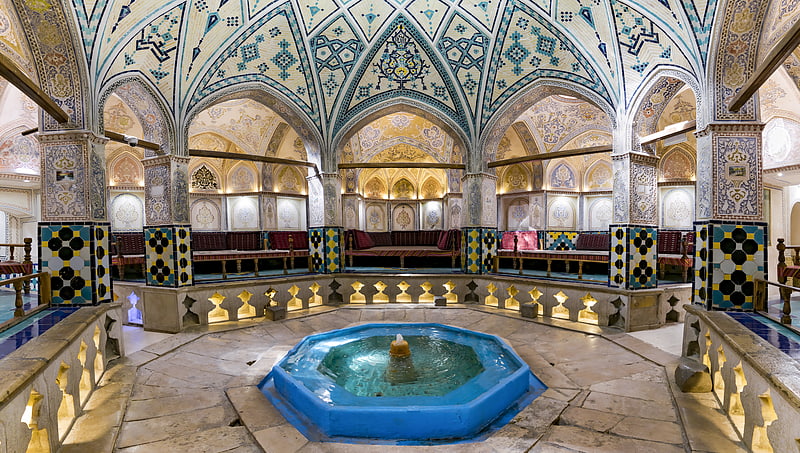
Also known as: حمام سلطان امیر احمد
Tourist attraction in Kashan, Iran. Sultan Amir Ahmad Bathhouse, also known as the Qasemi Bathhouse, is a traditional Iranian public bathhouse in Kashan, Iran. It was constructed in the 16th century, during the Safavid era; however, the bathhouse was damaged in 1778 as a result of an earthquake and was renovated during the Qajar era. The bathhouse is named after Imamzadeh Sultan Amir Ahmad, whose mausoleum is nearby.
Sultan Amir Ahmad Bathhouse, with an area of around 1000 square meters, consists of two main parts: the sarbineh (dressing hall) and garmkhaneh (hot bathing hall). The sarbineh is a large octagonal hall and has an octagonal pool in the middle, separated by 8 pillars from the outer section. There are four pillars in the garmkhaneh, which make smaller bathing rooms all around as well as the entrance section to the khazineh (final bathing room) in the middle. The interior of the bathhouse is decorated with turquoise and gold tilework, plasterwork, brickwork, as well as artistic paintings. The roof of the bathhouse is made of multiple domes that contain convex glasses to provide sufficient lighting to the bathhouse while concealing it from the outside.[2]
Tabatabai House
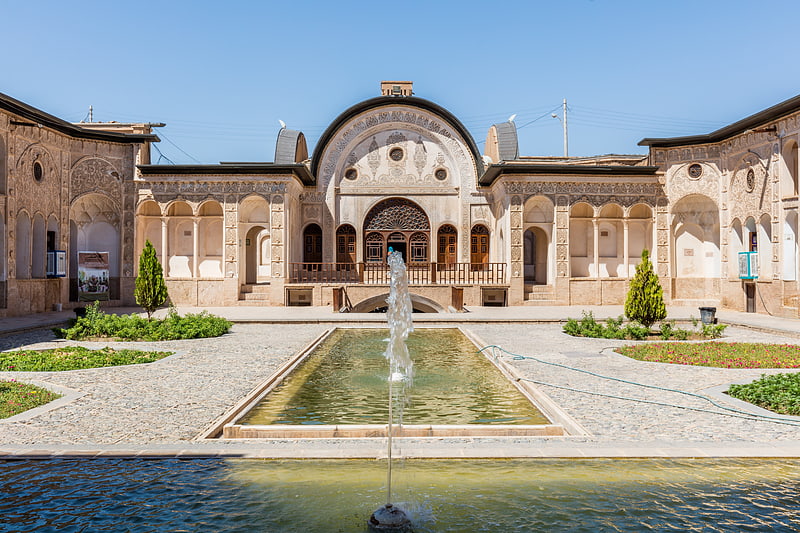
Also known as: خانه طباطباییها
Tourist attraction in Kashan, Iran. The Tabatabai House is a historic house museum in Kashan, Iran. It was built around 1880, during the reign of the Qajar dynasty, for the affluent Tabātabāei family. It is one of the prominent historic houses of Kashan and Iran, together with the Āmeri House, the Borujerdi House, and others.[3]
Āmeri House
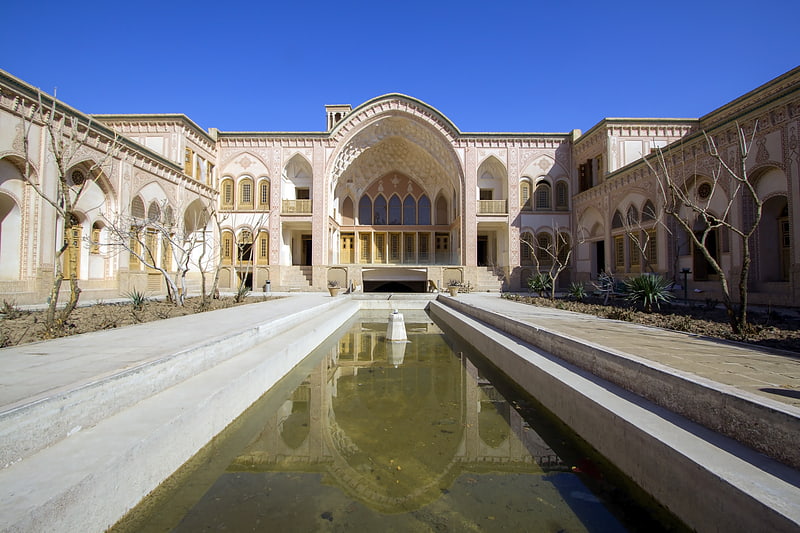
Also known as: خانه عامریها
Family. The Āmeris House is a large historic house in Kashan, Iran. It was originally built as a family residence during the reign of the Zand dynasty for Agha Āmeri, the governor of Kashan, and is now restored and transformed into a traditional-style hotel.
Like the other historic houses that are located nearby, the Āmeri House was damaged through earthquakes in the 18th century, and was then rebuilt in the 19th century. It is one of the prominent historic houses of Kashan, together with the Borujerdi House, the Tabātabāei House, and others.[4]
Tepe Sialk
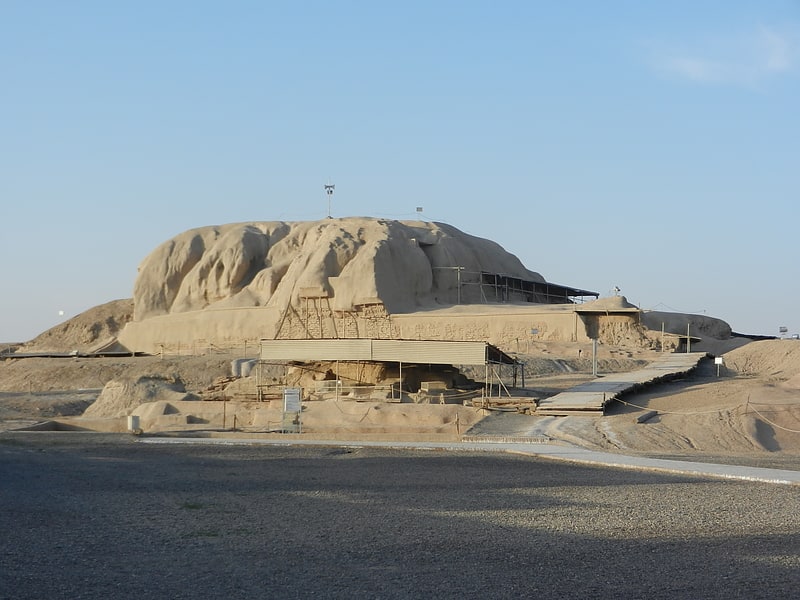
Also known as: تپه سیلک
Tepe Sialk is a large ancient archeological site in a suburb of the city of Kashan, Isfahan Province, in central Iran, close to Fin Garden. The culture that inhabited this area has been linked to the Zayandeh River Culture.[5]
Address: Pres d'Amir Kabir Street, 87134 Kashan
Agha Bozorg mosque

Also known as: مسجد آقابزرگ
Mosque in Kashan, Iran. Agha Bozorg mosque is a historical mosque in Kashan, Iran. The mosque was built in the late 18th century by master-mi'mar Ustad Haj Sa'ban-ali. The mosque and theological school is located in the center of the city.
Agha Bozorgh Mosque was constructed for prayers, preaching and teaching sessions held by Molla Mahdi Naraghi II also known as Mulla Mohammad Naraqi, known famously by his title of Āghā Bozorgh (literally meaning big or great lord) given to him by the Shah himself. Molla Mahdi Naraghi II was the son of the legendary Mulla Ahmad Naraqi (also spelled sometimes as Naraghi) who was the second strongest person in Iran after the king himself, Fath-Ali Shah Qajar. Mulla Ahmad Naraqi is well known for rallying the Iranian forces against the Russian invasion of northern Iran and declaring "jihad" or "holy war" against the invading Russians. He was successfully able to reconquer the Iranian lands that the invading Russian forces had captured during that offensive. Mulla Ahmad Naraqi, his brothers, his sons, and his father Mulla Muhammad Mahdi Naraqi famously known as Muhaqqiq Naraqi; are some of the most prominent Shi'a clerics as well as some of the most famous Islamic Iranian scientists of their time. Mulla Ahmad Naraqi and his father Muhaqqiq Naraqi are especially well known and honored to this day in Iran as the leading Islamic leaders of their time. It being the first time in Shi'a Twelver Islam that the helm of leadership of the faith was passed from father to son. Mulla Ahmad Naraqi was so accomplished in jurisprudence at the time of his father's passing (1209 AH/1795 CE) that it was agreed upon in a general consensus by the other leading figures of the time, to have Mulla Ahmad Naraqi as the next leader of the faith. Muhaqqiq Naraqi and Mulla Ahmad Naraqi's status in society at the time as leaders in both politics, jurisprudence, and faith can best be compared to the power and position held by Popes in the Catholic Church. They were in essence the leaders of the entire Twelver Shi'a world. With Mulla Ahmad Naraqi's passing in 1229 AH/1829 CE he was honored by being interred in the Shrine of Ali. His legacy holds as one of the most important and renowned Muslims in the past 1100 years and one of only a handful of Muslims who have been honored throughout history by being laid to rest in the Shrine of Imam Ali.[6]
Address: کوچه مسجد آقا بزرگ, Kashan
Tomb of Piruz Nahavandi
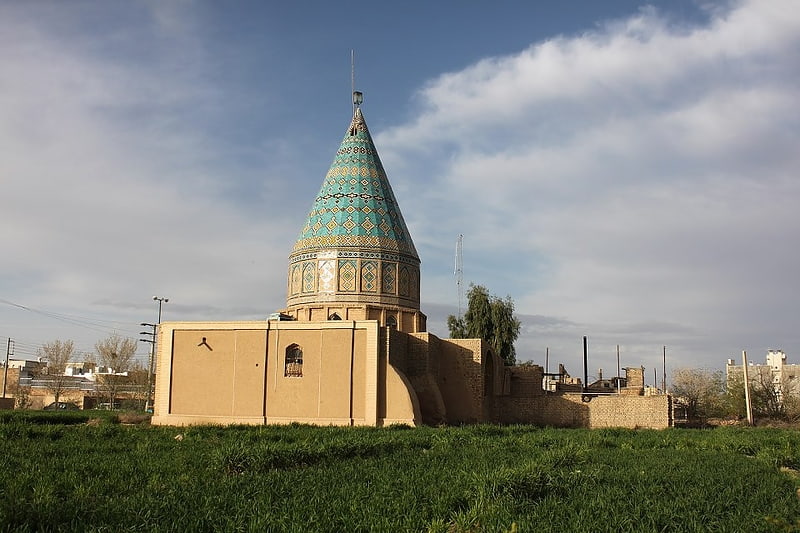
The Shrine of Abu Lu'lu'a is a mausoleum built over what is popularly believed to be the final resting place of Abu Lu'lu'a Firuz, a Persian slave who assassinated the second Islamic caliph Umar ibn al-Khattab in 644 CE. The structure was built by the Ilkhanid Mongols, and is located in Kashan, Isfahan Province, Iran.
The historical Abu Lu'lu'a died in Medina (the capital of the early caliphate, situated in the Arabian Peninsula) shortly after his assassination of Umar in 644 CE. However, in later times legends arose according to which Abu Lu'lu'a was saved from his pursuers by Ali ibn Abi Talib (the cousin and son-in-law of the prophet Muhammad, who is also revered by Shi'ite Muslims as the first Imam). As these stories would have it, Ali instantaneously transported Abu Lu'lu'a by means of a special prayer to Kashan, where he married and lived out the rest of his life.
During the 16th-century Safavid conversion of Iran to Shia Islam, a festival started to be celebrated in honor of Abu Lu'lu'a, commemorating his assassination of Umar ibn al-Khattab. Named Omar-koshan (lit. 'the killing of Umar'), it was originally held around Abu Lu'lu'a's sanctuary in Kashan, each year at the anniversary of Umar's death (26 Dhu al-Hijja of the Islamic year). However, later it also started to be celebrated elsewhere in Iran, sometimes on 9 Rabi' al-Awwal rather than on 26 Dhu al-Hijja. The festival celebrated Abu Lu'lu'a, nicknamed for the occasion Bābā Shujāʿ al-Dīn (lit. 'Father Courageous of the Faith'), as a national hero who had defended the religion by killing the oppressive caliph.
Due to political sensitivities, from the Qajar period (1789–1925) onward the festival gradually stopped being celebrated in the major cities of Iran, until it was eventually banned officially by the Islamic Republic of Iran in 1979. Nevertheless, the festival itself is still celebrated in Iran, though often secretly and indoors rather than outdoors. It is now held on the 9th day of the month of Rabi' Al-Awwal of the Islamic year, lasting until the 27th of the same month.
In recent years, controversy was caused when al-Azhar University demanded the Iranian government to demolish Abu Lu'lu'a's shrine. The issue caused the cancellation of diplomatic relations between the university and the Iranian government. These requests were made because the shrine was considered to be "offensive and un-Islamic" by mainstream Sunni scholars. Due to this Sunni pressure, which also included an intervention by the International Union for Muslim Scholars, it was reported that the Iranian government shut down the shrine in 2007.[7]
Aminoddole Carvansarai
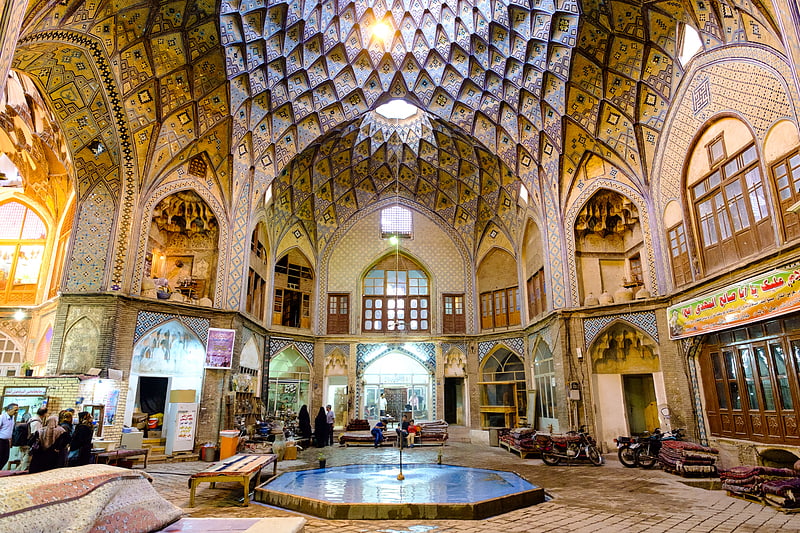
Aminoddole Plaza is one of the several plazas and perhaps the most majestic one in the grand Bazaar of Kashan, Iran.
The place mainly had been designed for commerce of merchandise but it is also being used for some important religious ceremonies in recent times. The most important one is Muharram, during which Hai'ats enter the place, sing elegies about tragic events happened to Hussain, the third Imam of Shi'a, and his close relatives in Karbala on the day of Ashura. It used to be an important place along the Silk Road. Its chambers traditionally served as a place for trading rugs woven by Kashanis or rugs brought from other cities. There are also some old antique shops and teahouses in the Timche plaza.[8]
Aran va Bidgol
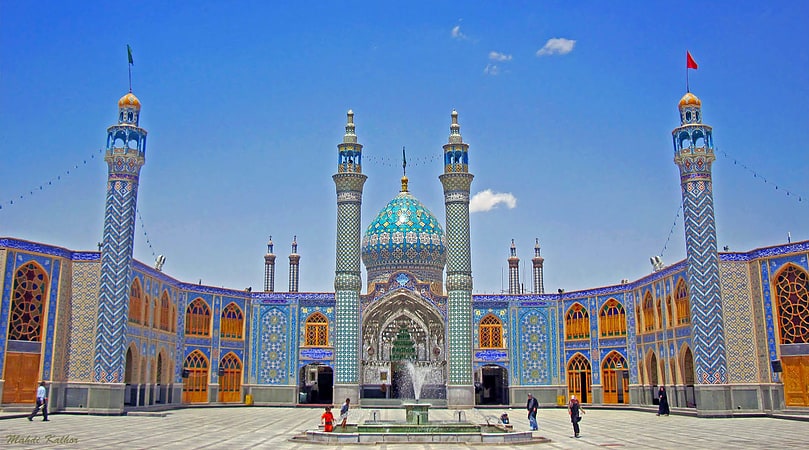
Also known as: آران و بیدگل
City in Iran. Aran o Bidgol is a city and capital of Aran va Bidgol County, Isfahan Province, Iran. At the 2006 census, its population was 55,651, in 15,556 families. It is one of the ancient desert cities of the province, close to Kashan.
As suggested by its name, the city is an amalgam of two formerly separate settlements: Aran (Persian: آران, also Romanized as Ārān and Arūn) and Bidgol.[9]
Borujerdis House
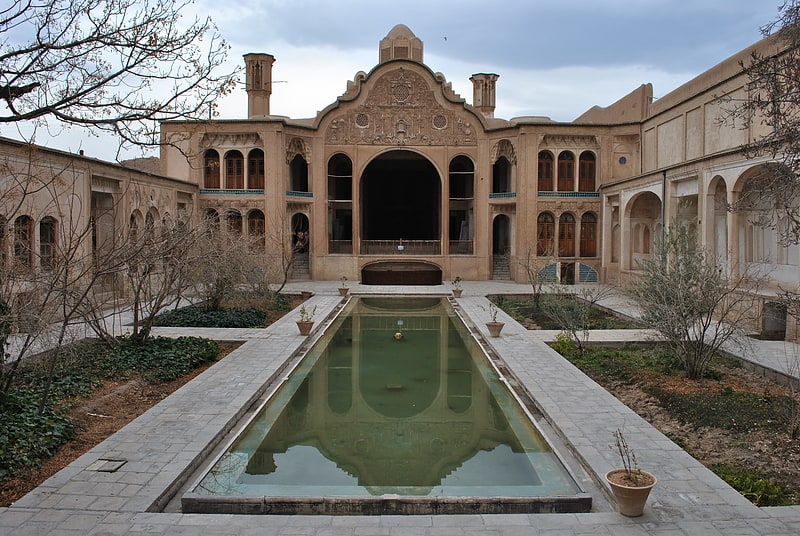
Also known as: خانه بروجردیها
Museum in Kashan, Iran. The Borujerdi House is a historic house museum in Kashan, Iran. It was built in 1857 by architect Ustad Ali Maryam for the bride of Borujerdi, a wealthy merchant. The bride came from the affluent Tabātabāei family, for whom the architect had built the nearby Tabātabāei House several years earlier.[10]
Meydan Mosque
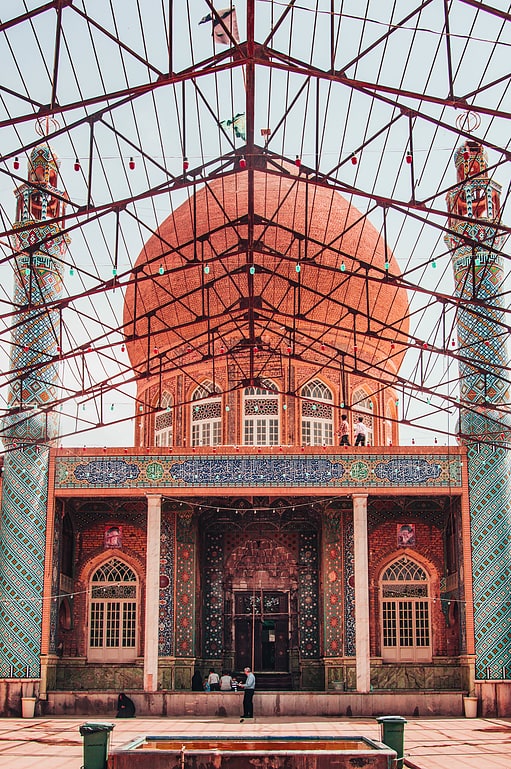
Also known as: مسجد میدان کاشان
Mosque. The Meydan mosque is a historical mosque in Kashan, Iran. It is located in the southern side of the Sang-e Ghadimi square and beside the Bazaar of Kashan. It is one of the oldest structures in Kashan. The primary structure belonged possibly to the seljuq era, but it was destroyed by the Mongols during their invasions. Later it was rebuilt and repaired by Khaje Emad ed-Din. A quotation for this matter is an inscription in the old mihrab, in which it is mentioned that it is built in 623 Hijri by Hassan ebn-e Arabschah in Kashan. The mihrab was in its original place until the last century, but it is kept now in the Museum of Islamic art in Berlin.
Jane Dieulafoy describes the mihrab as follows:
"Meydan mosque is a spacious structure with an appropriate architectural technique, but its distinctive characteristic in comparison with other similar structures is its exquisite mihrab, which is covered with splendid tiles with metal reflections. With respect to their high-quality these tiles are like the famous tiles of Imamzadeh Yahya in Varamin."Abd ol-Ghaffar Najm od-Dole predicted well in 1882 the future of the mihrab as follows:
"The embossed tiles, which I saw in the mihrab of Meydan mosque, were very interesting and spectacular. Westerners will buy them at least 2000 Tomans and will take the poor tiles away, if they can get a chance."The mosque had in its past glorious times high iwans, a splendid inner dome space, large yard, Shabestan and Howz hall, but despite many repairs most parts of the mosque have been destroyed. The mosque had a special social and political importance, which can be realized from many orders written above its portal. These orders date back to the 15th century in the Kara Koyunlu era until the 19th century in the Qajar era. These orders include guidelines, regulations and commands about the buying and selling of goods and food stuffs with approved prices of that time and about the prohibition of gamble and acts against the sharia.
The portal of the mosque stands out because of its pure Iranian architectural techniques.
The former stone minaret was destroyed in 1778 in the late Safavid era by an earthquake.[11]